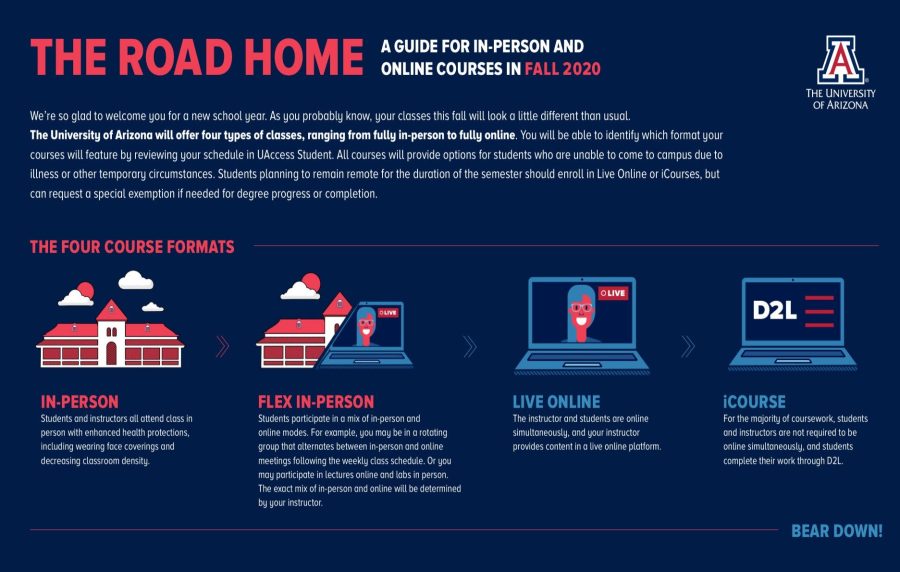In a weekly campus reentry briefing on July 16, University of Arizona President Dr. Robert C. Robbins announced that UA will officially be returning to campus in four different forms of learning: in-person, flex in-person, live online and iCourse. In line with Robbins’ goal to have 50% of campus in-person, two of these models will be some degree of in-person learning, including fully in-person and flex in-person.
RELATED: Here’s what the Student Union will look like in the fall
In-person classes will mean all sections of the class are in-person following Centers for Disease Control and Prevention guidelines with required face coverings and physical distancing, which means larger physical class spaces to enable the recommended six feet of social distancing. Flex in-person will be a mix of in-person and online learning, which will mostly be decided by the class’ instructor how they want to work within this format.
Students will have the ability to change their schedule as they see fit for the type of learning they desire, but even getting a few classes back to in-person will be a challenge based on the recent, now declining, spike in Arizona’s COVID-19 cases, even though everyone on campus is expected to social distance and wear face coverings.
Many professors at the UA have decided to teach their classes online due to safety concerns.
A lot of students, professors and faculty have family members or people they live with who are high-risk for COVID-19, and that is where a lot of the safety concerns stem from.
Jaime Fatas in Spanish and Portuguese and Vanessa Perry in disability psychoeducational studies are both professors at the UA who decided to go online for the fall 2020 term.
One of the reasons Perry decided to go online was due to pedagogy. The four modalities provide many different teaching environments for students. Some students will be learning in the class while others are learning from a distance.
“Those are really hard, it is hard to keep the students who aren’t in the classroom engaged while also trying to keep all the students in front of you engaged,” Perry said.
Robbins also said in the July 16 reentry press conference that live online will be fully online classes taught live over Zoom, with students and instructors online at the same time, and iCourse classes, which has been an option for students even before the pandemic, are taught fully online usually through lecture videos and assignments on a schedule for students to complete on their own.
Perry knew if she decided to teach in-person there would be some students who didn’t feel safe or who were sick, who would have to join from a distance. She felt that having all of her students learn from the same platform was the best choice.
Fatas expressed similar concerns and addressed them by stating in an email, “We need to take drastic safety and containment measures, however painful those are, until we get an effective vaccine or can bring it under control.”
Technology advances provide platforms like Zoom that allow professors to keep in touch with their students and to keep making progress through remote instruction.
Fatas also addressed that technology problems can occur and have a negative impact on students. It can lead to students feeling discouraged and becoming disengaged.
“Therefore, it works as a temporary solution but not as a replacement,” Fatas explained in an email.
Perry teaches graduate students and her concern is that most of her students will be online for work and school all day, so her worries are Zoom fatigue and learner engagement, in addition to students who are parents or caregivers for others in their home.
“If you are trying to sit in your online class at home and you have a baby you have to feed during class, it is a lot to juggle,” Perry explained.
Perry, like many other professors, changed some parts of the curriculum she teaches in order to provide a better online learning experience for her students.
Perry teaches counseling, and although counseling is mainly done online right now, when her students graduate it could be back to in-person.
“It is hard to teach a discipline online when it is performed in-person,” Perry said.
Perry added that it pains her to not be able to teach in person.
“However, it is the reality of our situation and to me the most important thing is our students and their wellbeing,” Perry said.
RELATED: U.S. Senators caution Robbins on Ashford University acquisition
Fatas decided to do live online because it allows him to present synchronously and to maintain regular direct contact with his students in a virtual live format.
“You see, we can see each other, check how everybody is doing, keep things personable and human, interactive and organic,” Fatas said in an email.
Fatas also provided curricular material asynchronously, so students can review and study throughout the week. He does this format so that within the limitations of remote online him and his students can have a meaningful, productive interaction.
“We need to do our best to support students, staff and faculty,” Fatas said, “by whatever means necessary so nobody loses their job, their classes and their hopes.”
Follow Jillian Bartsch and Maggie Rockwell on Twitter









